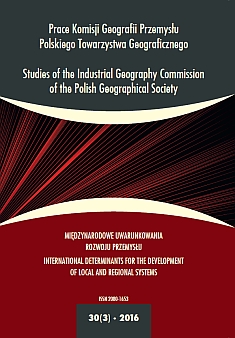The Similarities of Employment Structures in Industrial Sector in the Eu-27 Countries
DOI:
https://doi.org/10.24917/20801653.303.3Keywords:
agglomerative hierarchical clustering method, employment in industry sector, k-means clustering, similarities in the EU-27 countriesAbstract
The industrial sector is the one of key engine of economic growth especially in the developingcountries. The positive dynamics of change in industrial sectors lead to effects in other areas of economy. Thepaper focuses on the clustering of employment in industrial sector in the EU-27 countries in order to formhomogeneous clusters. The period considered is the year 2013. The choice of such a research period comesfrom the availability and comparability of the statistical data within the European Countries. The clusteringprocedure of EU countries is based on intra and inter-group differences on selected diagnostic variables. Theagglomerative hierarchical clustering and k-means clustering methods were used in the paper. The maincriteria for deciding on UE-27 countries belonging to clusters are the share of employment in manufacturingand the share of employment in construction. The countries of the EU-15, particularly Germany, Great Britain,France, Spain, Italy and separately Poland as well are characterized by higher values of average for selecteddiagnostic variables i.e. the share of employment in manufacturing and the share of employment in constructionin relation to the average of variables for the remaining countries.Downloads
Metrics
References
Appelbaum, E., Schettkat, R. (1999). Are Prices Unimportant? The Changing Structure of the Industrialized Economies. Journal of Post Keynesian Economics, 21(3), 387–398.
Balcerowicz-Szkutnik, M., Sojka, E. (2011). Pokolenie 50+ na europejskim rynku pracy – podsumowanie poszczególnych etapów badań. Katowice: Uniwersytet Ekonomiczny w Katowicach, 9–20.
Blinder, A.S. (2007a). How Many U.S. Jobs Might Be Offshorable? CEPS Working Paper, 142, 1–45.
Blinder, A.S. (2007b). Offshoring: Big Deal, orBusiness as Usual? CEPS Working Paper, 149, 1–39.
D’Agostino, A., Serafini, R., Ward-Warmedinger, M. (2006). Sectoral Explanations of Employment in Europe. The Role of Services. Working Paper Series, 625, 3–59.
Goos, M., Manning, A., Salomons, A. (2009). Job polarization in Europe. The American Economic Review, 99(2), 58–63.
Eurostat (2015, 20 listopada). Pozyskano z http://ec.europa.eu/eurostat (Statistic Database: Data Navigation Tree) International Labour Organization (2013). Global Employment Trends 2013. Recovering from a second jobs dip. Geneva, 3–170.
International Labour Organization (2014). Global Employment Trends 2014. Risk of a jobless recovery? Geneva, 3–126.
International Labour Organization (2015, 20 listopada). Pozyskano z http://www.ilo.org Katouzian, M.A. (1970). The Development of the Service Sector: A New Approach. Oxford Economic Papers, 22(3), 362–382.
Mojena, R. (1997). Hierarchical Grouping Methods and Stopping Rules: An Evaluation. Computer Journal, 20(4), 359–363.
Staritz, C. (2010) (2016, 18 lipca). Making the Cut? Low-Income Countries and the Global Clothing Value Chain in a Post-quota and Post-crisis World. The World Bank. Pozyskano z http://documents.worldbank.org/curated/en/2011/01/13362258/making-cut-low-income-countries- global-clothing-value-chain-post-quota-post-crisis
World United Nations Industrial Development Organization (2013). Industrial Development Report 2013, Sustaining Employment Growth: The Role of Manufacturing and Structural Change. Vienna, 3–246.
Downloads
Published
How to Cite
Issue
Section
License
Articles are published under the terms of the Creative Commons License (CC BY-ND 4.0; Attribution– NoDerivs).

